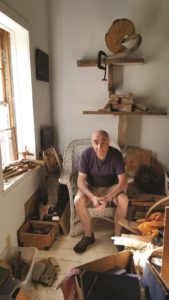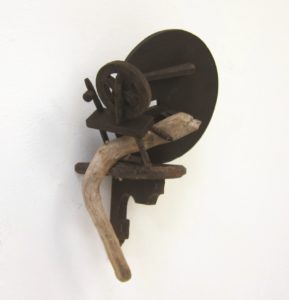“The beach used to smell like hell,” sculptor Paul Bowen says. He is seated at a workbench in his studio on the top floor of a rugged barn that was once used for storing hay and lumber in Williamsville, Vt. Bowen is recalling a day in Provincetown in the 1980s when a whale washed ashore within shouting distance of MacMillan Wharf. Bowen was then a year-rounder, an inveterate hunter of wooden fragments that were abundant along the backshore and bay, including pine slats used for packing fish. He had come to Provincetown in the mid-1970s for a Fine Arts Work Center fellowship and because of its reputation as an artist colony.

Bowen, a bard in the Celtic tradition, has brought up the beached whale as part of the backstory for Flense, one of the dozen-plus small-scale sculptures of his in a show opening this weekend at Albert Merola Gallery in Provincetown. On that day in the ’80s, he was photo-documenting a crew from the New England Aquarium as they performed a whale necropsy. They began by removing the coal black top layer of whale skin, Bowen says, a procedure that is called flensing, the first step in processing whale blubber into oil.
The material components of Flense are straightforward: four thick bands of coal black fabric, mounted on a wooden board. Bowen’s titles are not to be taken literally — they serve as pathways to richer meanings.
“When I lived in Provincetown, I didn’t drive,” he says. “I carried each piece of wood by hand, or on my bike, to the studio. I could walk the backshore, pass by hundreds of pieces of wood, and choose maybe two. I’d have a relationship with every piece.”
Many of those relics came with him to Vermont. “My house,” he says, partially in jest, “is filled to the rafters with wood. I often work on many pieces at the same time. A lot of the work ends up on the wall, on the workbench, on the floor. Because there are all these boxes of wood, inevitably — accidentally — something gets dropped, and often, something better happens than what I have been working on. I will seize that moment and pursue it.”
Bowen moves on to Dowser, another work in his Merola gallery show. In the process of making it, he turned two separate sculptures into a twinned and layered unit, 20 inches across. The top layer of Dowser tilts upward to the left. It has two ovals: one glides over a partial circle of black, suggesting dark water meeting the horizon line. The other opens to raw wood and “butterfly” shapes, a signature element, alluding to furniture-making before metal joints. Choreographed with a painter’s eye — Bowen was transitioning from painting to sculpture when he studied at Maryland Institute College of Art — the wingspan of the topmost butterfly is painted bright white, animating the surface.
Materials steeped in history remain Bowen’s creative North Star: the base layer of Dowser is a breadboard from his family home in Wales. “I like that kind of connection,” he says. “The thing you always hope for is to allow the material to make itself the way it’s always wanted to be.”

Bowen’s Welsh origins — he was born there in 1951 — remain a powerful influence. Artist slide shows he used to give at FAWC would open with shots of Colwyn Bay, the seaside resort town where he grew up. Black tar would wash up, often attached to floating pieces of wood, and Bowen’s sculptures once incorporated petroleum-based material, now known to be toxic, that approximates that dense tar. Today, to get opaque blacks, he will hand-paint fabrics, or use a black plumber’s glue. His Merola show, “Tar Flats,” refers to the old practice of fishermen tarring their nets on the beach.
Another piece, Wedges Stack, is named for its multiple layers of triangular shapes, which look as if they were tossed in a game of pick-up sticks and positioned as they landed. The wood, Bowen says, drifted in from the area around MacMillan Wharf, a by-product of pier construction.
“I may work on things over a very long period of time,” Bowen says. “Certain parts take a long time to get to the place where you’re done. Often, it’s the nature of the wood. Unlike working in marble or steel, wood is a mutable medium, reflecting the history of its own ebb and flow, the contours of the land, the pull of the tides.”
Bowen lived and worked in Provincetown for three decades. He showed at Long Point Gallery, DNA, and ArtStrand. Since 2014, he’s been at Merola. He and writer Pamela Mandell met at FAWC, when Mandell was an administrator and Bowen was the visual arts coordinator. They married in 2000. They moved in 2005, when year-round living and studio space in Provincetown became unsustainable.

Bowen reconnects with the Outer Cape each summer, teaching at FAWC and the Truro Center for the Arts at Castle Hill. Locally, his work is in the collections of the Provincetown Art Association and Museum and the Cape Cod Museum of Art, and, nationally, he’s in the Museum of Fine Arts, Boston; the Solomon R. Guggenheim Museum in New York City; and the Walker Art Center in Minneapolis.
Bowen credits his roots here with anchoring a productive life. “All the good things that have happened to me — materials, career, friendships, and a supportive gallery — happened because of Provincetown,” he says. “My house is full of Provincetown things.”
Wood as Muse
The event: “Tar Flats,” artwork by Paul Bowen
The time: Friday, Aug. 14, through Sept. 2; Wednesday through Sunday, noon to 5 p.m., and by appointment (508-487-4424)
The place: Albert Merola Gallery, 424 Commercial St., Provincetown
The cost: Free



